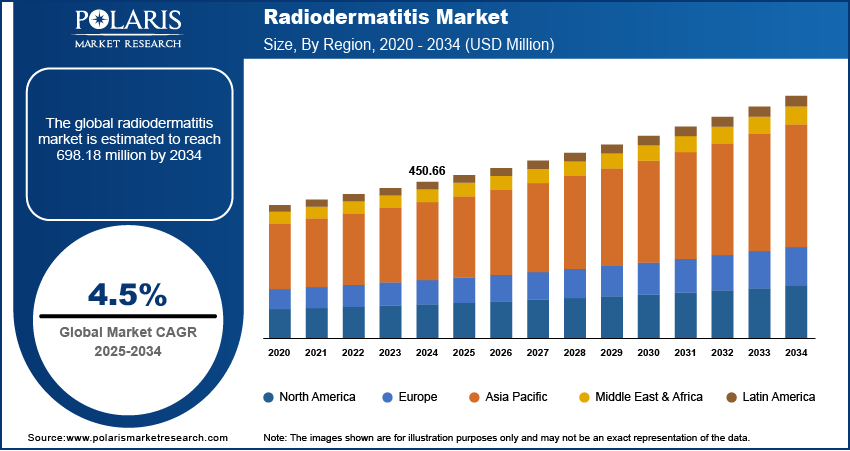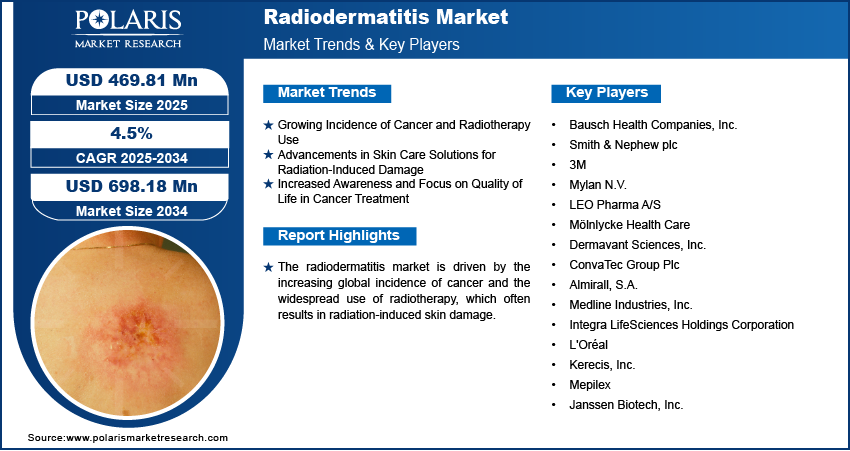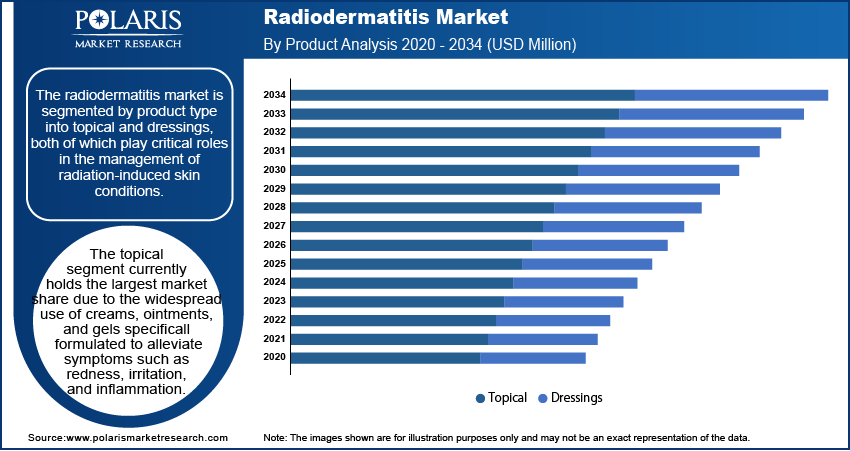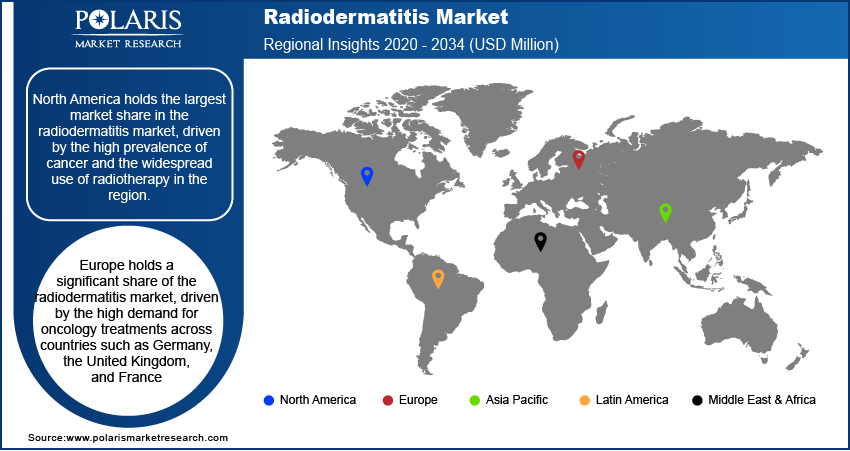
Radiodermatitis Market Size, Share, Trends, Industry Analysis Report
: By Product (Topical and Dressings), Distribution Channel, and Region (North America, Europe, Asia Pacific, Latin America, and Middle East & Africa) – Market Forecast, 2025–2034
- Published Date:Aug-2025
- Pages: 118
- Format: PDF
- Report ID: PM2963
- Base Year: 2024
- Historical Data: 2020-2023
Market Overview
The radiodermatitis market size was valued at USD 450.66 million in 2024, growing at a CAGR of 4.5% during 2025–2034. The growing incidence of cancer globally and the rising use of advanced skincare solutions are a few of the key factors propelling market expansion.
Key Insights
- The topical segment accounts for the largest market share. The segment’s dominance is primarily attributed to the widespread use of creams and gels specifically formulated for symptoms like irritation and inflammation.
- The online pharmacies segment is registering the fastest growth, owing to the increasing trend of e-commerce in the healthcare sector.
- North America accounts for the largest market share. The regional market dominance is primarily attributed to its high prevalence of cancer and widespread radiotherapy use.
- Asia Pacific is witnessing substantial growth. The rising number of cancer patients undergoing radiotherapy treatments has led to increased demand for specialized products for managing radiodermatitis.
Industry Dynamics
- The rising global cancer prevalence continues to drive the demand for effective solutions for managing radiation-induced skin conditions, fueling market expansion.
- The ongoing innovation in skincare solutions, including the introduction of advanced topical creams and wound dressings, designed specifically for the management of radiodermatitis, drives market growth.
- Increased emphasis on tailoring treatments for individual patient needs is expected to provide significant market opportunities.
- The high cost of procedures may impede market growth.
Market Statistics
2024 Market Size: USD 450.66 million
2034 Projected Market Size: USD 698.18 million
CAGR (2025-2034): 4.5%
North America: Largest Market in 2024

To Understand More About this Research: Request a Free Sample Report
Radiodermatitis refers to the skin condition that results from exposure to ionizing radiation, commonly occurring in patients undergoing radiotherapy for cancer treatment. The market for radiodermatitis is driven by the growing incidence of cancer worldwide, which leads to an increased demand for radiotherapy treatments. Additionally, the rise in awareness regarding skin care during and after radiotherapy has spurred the development of specialized products and therapies for managing radiodermatitis. Some other key drivers include the growing use of advanced skincare solutions such as topical ointments, gels, and dressings designed to alleviate symptoms and promote skin healing. Increased research into radiodermatitis treatment options and the development of new therapies are expected to further propel radiodermatitis market growth.
Market Dynamics
Growing Incidence of Cancer and Radiotherapy Use
The increasing global prevalence of cancer is one of the primary drivers for the radiodermatitis market. According to the World Health Organization (WHO), cancer is one of the leading causes of death worldwide, with an estimated 19.3 million new cases and nearly 10 million cancer deaths in 2020. As cancer treatments continue to evolve, radiotherapy remains a cornerstone, with a significant portion of patients undergoing this treatment experiencing skin reactions such as radiodermatitis. This rising number of radiotherapy patients is directly linked to the demand for effective solutions to manage radiation-induced skin conditions. The market for radiodermatitis is thus expanding in tandem with the growing number of cancer diagnoses and treatments.
Advancements in Skin Care Solutions for Radiation-Induced Damage
The continuous innovation in skincare solutions designed specifically for managing radiodermatitis is another key factor propelling the market growth. Over the past few years, new products, including topical creams, ointments, and wound dressings, have been developed to treat radiation-induced skin damage. These advanced skincare solutions offer relief from symptoms such as redness, irritation, and peeling, and help accelerate healing. According to a study published in the Journal of Clinical Oncology, using these products significantly improves the quality of life for patients undergoing radiotherapy, which further drives demand. The introduction of novel formulations, including those with natural ingredients such as aloe vera and hyaluronic acid, is also gaining popularity for their soothing and healing properties.
Increased Awareness and Focus on Quality of Life in Cancer Treatment
An increasing focus on enhancing the quality of life for cancer patients is influencing the demand for effective radiodermatitis treatments. As more patients and healthcare providers recognize the importance of managing side effects such as radiodermatitis, the demand for targeted skincare products rises. Healthcare professionals now prioritize the mitigation of radiation-induced skin reactions to improve patient comfort and reduce the risk of long-term skin damage. A 2020 report by the American Society of Clinical Oncology (ASCO) highlights that approximately 95% of radiotherapy patients will experience some form of skin reaction, thus emphasizing the necessity for preventive and therapeutic options. This growing emphasis on patient well-being is driving the adoption of specialized treatments and supporting the radiodermatitis market expansion.

Segment Insights
Market Assessment by Product
The radiodermatitis market is segmented by product type into topical and dressings, both of which play critical roles in the management of radiation-induced skin conditions. The topical segment currently holds the largest radiodermatitis market share due to the widespread use of creams, ointments, and gels specifically formulated to alleviate symptoms such as redness, irritation, and inflammation. These products are preferred by both patients and healthcare providers for their ease of application and effectiveness in providing immediate relief. The topical solutions market is also benefiting from advancements in product formulations, such as those incorporating natural ingredients such as aloe vera and vitamin E, which are known for their healing properties.
The dressings segment is also registering the highest rate of expansion. This is largely due to the increasing adoption of advanced wound care technologies that address more severe cases of radiodermatitis, especially in patients undergoing high-dose radiation. Dressings designed to promote faster healing, manage infection risks, and minimize scarring are gaining traction in clinical settings. These products, often combined with antimicrobial agents or hydrocolloids, help provide a protective barrier and accelerate skin recovery. With the rise in personalized patient care and emphasis on reducing long-term skin damage, the demand for specialized dressings is expected to grow at a faster pace in comparison to other product types.
Market Evaluation by Distribution Channel
The radiodermatitis market segmentation, based on distribution channel, includes hospital pharmacies, retail pharmacies, and online pharmacies. Hospital pharmacies hold the largest market share, primarily driven by the direct association with patient care in clinical settings. Healthcare providers typically recommend and distribute radiodermatitis treatments through hospital pharmacies, particularly for patients undergoing radiotherapy. These pharmacies are well-equipped to offer specialized products, including those that are prescribed or administered during hospital visits. The convenience of accessing treatment through a trusted healthcare provider enhances the dominance of this segment in the overall market.
Online pharmacies are also experiencing the fastest growth due to the increasing trend of e-commerce in the healthcare sector. Patients, particularly those in remote areas or those seeking convenience, are increasingly turning to online platforms to purchase radiodermatitis treatments. The availability of a wide range of products and the ease of home delivery are driving the demand for online pharmacies. Furthermore, the growing acceptance of online healthcare services and telemedicine is contributing to the expansion of this segment. The rising consumer preference for shopping from home, coupled with the ability to access specialized treatments easily, positions online pharmacies as the fastest growing distribution channel in the radiodermatitis market.

Regional Insights
By region, the study provides radiodermatitis market insights into North America, Europe, Asia Pacific, Latin America, and the Middle East & Africa. North America holds the largest market share, driven by the high prevalence of cancer and the widespread use of radiotherapy in the region. The presence of advanced healthcare infrastructure, along with the availability of a wide range of specialized treatment options, significantly contributes to the region’s dominance. The growing number of cancer diagnoses in the US, supported by a robust healthcare system and increasing awareness about radiation-induced skin conditions, has led to a strong demand for radiodermatitis treatments. Additionally, significant research and development in the field of oncology and skin care have resulted in the introduction of innovative products tailored for managing radiodermatitis, further boosting the market in North America. Other regions, such as Europe and Asia Pacific, are also seeing steady growth but do not yet match the scale of North America in terms of market share.
Europe holds a significant radiodermatitis market share, driven by the high demand for oncology treatments across countries such as Germany, the Uk, and France. The increasing number of cancer patients requiring radiotherapy in Europe has led to a growing need for effective solutions to manage radiation-induced skin damage. Additionally, the region benefits from a well-established healthcare system, with access to advanced skincare products and therapies specifically designed for radiodermatitis. The rising awareness about patient quality of life during cancer treatment and government initiatives to enhance cancer care further contribute to the market growth in Europe. However, market growth in Europe is somewhat slower compared to North America due to healthcare budget constraints and differences in healthcare access across countries.
Asia Pacific is experiencing substantial growth in the radiodermatitis market, driven by the increasing incidence of cancer, particularly in countries such as China, Japan, and India. The growing number of cancer patients undergoing radiotherapy treatments has heightened the need for specialized skincare products for managing radiodermatitis. Rapid advancements in healthcare infrastructure, along with the rising availability of affordable treatment options, have positively impacted the market. Furthermore, increasing awareness about cancer treatment side effects and the availability of online pharmacies are boosting the demand for radiodermatitis products in the region. Despite these positive trends, market penetration remains varied across the region due to differences in economic development, with more significant growth in developed countries including Japan compared to emerging economies such as India.

Key Players and Competitive Insights
Key players in the radiodermatitis market include major pharmaceutical and healthcare companies such as Bausch Health Companies, Inc.; Smith & Nephew plc; 3M; Mylan N.V.; and LEO Pharma A/S. Other notable companies are Mölnlycke Health Care, Dermavant Sciences, Inc., and ConvaTec Group Plc. Additionally, companies such as Almirall, S.A.; Medline Industries, Inc.; and Integra LifeSciences Holdings Corporation are actively contributing to the market with their product offerings. Other important players include L'Oréal, Kerecis, Inc.; Mepilex; and Janssen Biotech, Inc.; which provide specialized products for the treatment and prevention of radiodermatitis. These companies have developed a wide range of topical treatments and wound care solutions to manage skin reactions caused by radiotherapy.
The competitive landscape of the radiodermatitis industry is characterized by a range of companies offering innovative and effective products aimed at managing skin damage from radiotherapy. Companies such as Bausch Health and Smith & Nephew have robust portfolios of skincare products, while others, such as 3M and Mylan, offer more specialized solutions for radiation-induced skin reactions. As the market continues to grow, many of these companies are focusing on expanding their product lines, enhancing existing formulations, and introducing new therapies to address the evolving needs of cancer patients. Collaborations and partnerships between these players and healthcare providers are becoming increasingly important to expand their market reach and improve patient outcomes.
In addition to offering topical treatments and dressings, some companies are focusing on improving patient access through digital channels such as online pharmacies and e-commerce platforms. With the increasing demand for personalized healthcare solutions, companies are also prioritizing the development of products that cater to specific needs, such as wound care and infection prevention. The competitive environment is further shaped by ongoing research and development efforts to create more effective solutions with minimal side effects, as well as an emphasis on patient education to increase awareness of radiodermatitis and its management options. This market is expected to witness steady growth as these companies continue to innovate and address unmet needs in the treatment of radiodermatitis.
Bausch Health Companies, Inc. is a global company that offers a range of products, including those for the treatment of radiodermatitis. Their portfolio includes skincare solutions designed to alleviate the symptoms of skin reactions caused by radiotherapy. Bausch Health is active in the development and distribution of products to manage various dermatological conditions, with a focus on improving patient comfort and outcomes during cancer treatments.
Smith & Nephew plc is a multinational company that provides medical devices and advanced wound care solutions, including those aimed at managing radiodermatitis. The company is involved in developing and supplying products that help treat skin damage resulting from radiation therapy. They focus on creating solutions that help heal wounds and reduce the risk of infection, with a strong emphasis on patient care.
List of Key Companies
- Bausch Health Companies, Inc.
- Smith & Nephew plc
- 3M
- Mylan N.V.
- LEO Pharma A/S
- Mölnlycke Health Care
- Dermavant Sciences, Inc.
- ConvaTec Group Plc
- Almirall, S.A.
- Medline Industries, Inc.
- Integra LifeSciences Holdings Corporation
- L'Oréal
- Kerecis, Inc.
- Mepilex
- Janssen Biotech, Inc.
Radiodermatitis Industry Developments
- November 2024: Bausch Health announced the launch of a new line of skincare products specifically formulated to treat radiodermatitis. This product addresses the growing need for specialized treatments in oncology care.
- October 2024: Smith & Nephew introduced a new range of wound care dressings designed to aid in the healing process for patients experiencing radiation-induced skin reactions, signaling their continued investment in this area of healthcare.
Market Segmentation
By Product Outlook (Revenue-USD Million, 2020–2034)
- Topical
- Dressings
By Distribution Channel Outlook (Revenue-USD Million, 2020–2034)
- Hospital Pharmacies
- Retail Pharmacies
- Online Pharmacies
By Regional Outlook (Revenue-USD Million, 2020–2034)
- North America
- US
- Canada
- Europe
- Germany
- France
- UK
- Italy
- Spain
- Netherlands
- Russia
- Rest of Europe
- Asia Pacific
- China
- Japan
- India
- Malaysia
- South Korea
- Indonesia
- Australia
- Vietnam
- Rest of Asia Pacific
- Middle East & Africa
- Saudi Arabia
- UAE
- Israel
- South Africa
- Rest of Middle East & Africa
- Latin America
- Mexico
- Brazil
- Argentina
- Rest of Latin America
Report Scope
|
Report Attributes |
Details |
|
Market Size Value in 2024 |
USD 450.66 million |
|
Market Size Value in 2025 |
USD 469.81 million |
|
Revenue Forecast by 2034 |
USD 698.18 million |
|
CAGR |
4.5% from 2025 to 2034 |
|
Base Year |
2024 |
|
Historical Data |
2020–2023 |
|
Forecast Period |
2025–2034 |
|
Quantitative Units |
Revenue in USD million and CAGR from 2025 to 2034 |
|
Report Coverage |
Revenue Forecast, Market Competitive Landscape, Growth Factors, and Industry Trends |
|
Segments Covered |
|
|
Regional Scope |
|
|
Competitive Landscape |
|
|
Report Format |
|
|
Customization |
Report customization as per your requirements with respect to countries, regions, and segmentation. |
How is the report valuable for an organization?
Workflow/Innovation Strategy: The radiodermatitis market has been segmented into detailed segments of product and distribution channel. Moreover, the study provides the reader with a detailed understanding of the different segments at both the global and regional levels.
Growth/Marketing Strategy: The growth strategy for the radiodermatitis market focuses on expanding product offerings through continuous research and development aimed at improving the effectiveness of treatments for radiation-induced skin damage. Companies are investing in the development of innovative, easy-to-use topical solutions and advanced wound care dressings. Increasing awareness about the importance of managing skin reactions during cancer treatment and leveraging digital platforms for patient education are also key components of marketing strategies. Partnerships with healthcare providers, hospitals, and online pharmacies are vital to expanding market reach. Additionally, targeting emerging markets where cancer cases are rising presents significant growth opportunities for companies.
FAQ's
The radiodermatitis market size was valued at USD 450.66 million in 2024 and is projected to grow to USD 698.18 million by 2034.
The market is projected to register a CAGR of 4.5% during the forecast period, 2025-2034.
North America had the largest share of the market
Key players in the radiodermatitis market include major pharmaceutical and healthcare companies such as Bausch Health Companies, Inc.; Smith & Nephew plc; 3M,; Mylan N.V.; and LEO Pharma A/S. Other notable companies are Mölnlycke Health Care; Dermavant Sciences, Inc.; and ConvaTec Group Plc.
The topical segment accounted for the larger share of the market in 2024
The hospital pharmacies segment accounted for the larger share of the market in 2024.
Radiodermatitis is a skin condition caused by exposure to ionizing radiation, commonly occurring in patients undergoing radiotherapy for cancer treatment. It involves inflammation, redness, irritation, dryness, and peeling of the skin, which can range from mild to severe, depending on the intensity and duration of radiation exposure. Radiodermatitis typically affects the areas of the skin that are directly exposed to radiation, and in some cases, it can lead to more serious conditions such as ulceration or infection. Managing radiodermatitis is crucial to improving patient comfort and quality of life during cancer treatment.
A few key trends in the market are described below: Growing Focus on Skin Care Products: Increased demand for specialized skincare solutions, such as topical creams, ointments, and dressings, designed to manage radiation-induced skin damage. Adoption of Advanced Wound Care: Rising use of advanced wound care dressings that promote faster healing, manage infections, and reduce scarring in radiodermatitis patients. Personalized Treatment Options: Development of personalized treatment options to cater to individual patient needs, especially in high-dose radiation therapies. Rise in Cancer Incidences: Increasing number of cancer diagnoses globally, leading to a higher demand for radiotherapy treatments and subsequently, radiodermatitis management solutions.
A new company entering the radiodermatitis market could focus on developing innovative and personalized skincare solutions that cater to the specific needs of radiotherapy patients. Emphasizing the use of natural and organic ingredients for soothing and healing could help differentiate products in a market increasingly driven by consumer demand for safe, gentle formulations. Establishing strong partnerships with healthcare providers, oncology centers, and online pharmacies can enhance distribution and patient access. Additionally, investing in patient education initiatives and utilizing digital platforms for awareness could create a competitive edge. Targeting emerging markets with rising cancer incidences also presents opportunities for growth.
Companies manufacturing, distributing, or purchasing radiodermatitis and related products, and other consulting firms must buy the report.
